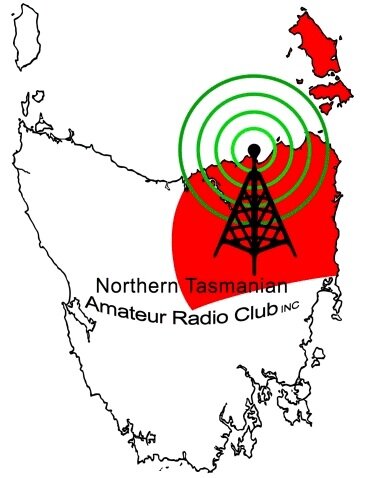Broadcast - 17 Nov 2024
There are still a couple of carry-over items from the previous Club Room Technical Night.
First up was Ian VK7IG, who had a rack mountable RMA900 series receiver set up on the work bench.
He was using it to demonstrate his new RF “noise source” unit that was designed by BG7TBL and available on the internet. It uses a reverse biased Zener as the noise source heart and generates random noise in the 138 MHz to 4.4 GHz region. Although not linear across the entire spectrum, for most limited bandwidth measurements the linearity is more than adequate for go-no-go testing, plotting and visualising. You can always do a baseline plot, over the desired frequency range, to ascertain the noise linearity as a reference before the device to be analysed is put into circuit.
For the demonstration Ian had tapped into the 35 MHz IF output of the RMA900 and fed it to his TinySA Ultra spectrum analyser. Connecting the “noise source” to the input to the receiver allowed you to see the curve of the IF passband on the TinySA. Some excellent displayed results were forthcoming.
A link to a tutorial on general testing using this device is included in the text version of this broadcast.
RTL-SDR Tutorial: Measuring filter characteristics and antenna VSWR with an RTL-SDR and noise source
For interest the RMA900 units were made in Australian by AWA and with its matching transmitter pair they made up one end of a 900MHz point to point link system. The basic system comprised a 900 MHz transmitter, diplexer, and receiver at each end. A link provided 60 voice channels and a sub-baseband channel, commonly called an order wire, for the technicians to talk over the link. These were extensively used throughout Australia from the 1980’s and proved to be very reliable. This wasn’t the actual show and tell item but it certainly brought back some fond memories.
Ian also brought in a small USB-C socketed printed circuit board, it was very cute but what did it do?
It had been designed to mimic a device that requires a certain DC voltage. While powered down simply select and set the three on board dip switches for the voltage required. Then connect to the USB-C power source using the appropriate USB-C to C cord. On powering up it communicates with the USB-C power source, mimics the protocol and requests a specific voltage. The user selected voltage of 5, 9, 12, 15 or 20 Volts will appear at the board’s output terminals.
How simple is that! I have already placed an order for some of these tiny boards, thank you Ian for the demonstrations.
Idris VK7ZIR brought in a new acquisition, well new to him, considering it was actually manufactured back in 1946. He had a fine example of a classic Eddystone 504 General Coverage Communications Receiver. This is a Single Conversion Superheterodyne receiver with a compliment of ten valves and a coverage spanning from 600 kHz to 30 MHz divided into five selectable bands. This particular model is also referred to as the S 504 as it has an “S” preceding the model number on the tuning dial. This evidently refers to the fact it was manufactured by Stratton & Company Ltd. in Birmingham England. This means the radio was manufactured nearly twenty years before Eddystone was acquired by the Marconi Company in 1965. Nowadays this unit is considered and is listed as “Extremely Scarce”, especially one in such a good condition. Hopefully it is destined for restoration and a pride of place amongst its other Eddystone siblings.
Idris’s next acquisition up for perusal brought us forward into the 1960’s.
A Tektronix RM504 oscilloscope, this is the rarer rack mountable version of the 504 which was the usual workshop style. Must have been something about rare objects that night, Hi-Hi.
These models were DC to 450 kHz vertical input bandwidth and not intended for wideband laboratory work. Being a reduced bandwidth unit also came with a much reduced price tag, which undoubtedly kept the “Bean Counters” happier. It was usually found mounted in racks of fixed communications equipment permanently monitoring signals from selected sources.
Not sure what you intend using it for Idris, but it certainly is in very good condition.
As always, pictures will be available on the NTARC Web site under “Blogs” for this broadcast. NTARC Blogs
UPCOMING EVENTS
TestNet and TechNet session - Every Wednesday, TestNet/CW course on 3.580MHz from 7 pm till 7.30 pm, then a TechNet on 3.567MHz from 7.30 pm till 8.30 pm. Your host for the evening is Nic VK7WW.
Club Room Technical night session - The next session will be on Wednesday the 20th November and will commence at the usual time of 6.30 pm at the Club Room Archer Street, Rocherlea.
Coffee Morning - held every Friday in the NTARC Club rooms. Time is from 10 am to noon and we look forward to seeing you all there. So why not pop in check the QSL cards and join us for a cuppa, there is endless tea and coffee along with biscuits available for a donation.
End of year NTARC celebration – locked in for Wednesday the 4th of December.
Finally - A reminder to all members that if you have any items of news you would like added to our weekly roundup, no matter how trivial, then please email them to the Secretary at the following address news@ntarc.net all items to be received no later than 5 pm on the Friday prior to the Broadcast.
That’s all folks,
73, Stefan VK7ZSB, Secretary NTARC Inc.








